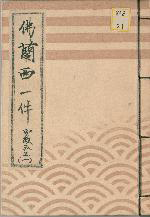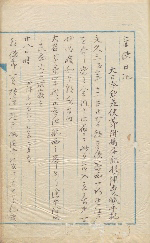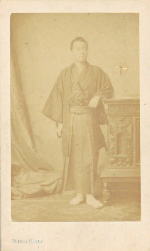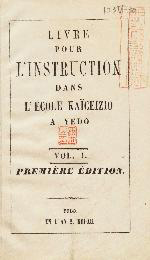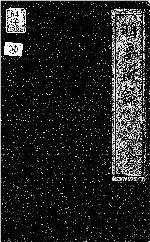![]()
Section 1: The meeting of the Edo Shogunate and France
The first time French people visited Edo was upon the conclusion of the Japan-France Treaty of Amity and Commerce which was one of the Ansei commercial treaties. Records from Edo at the time show that there was a sense of wariness about the foreigners with whom there had been hardly any contact up until then.
The diplomatic missions, which sought to reduce the severity of the restrictions of the concluded treaties, visited Europe, including France, and came back with new knowledge.
Meanwhile, in order to comply with the necessity for new diplomatic work, the Kaisei-jo was established in Edo as a Shogunate government facility for Western studies and private schools were also opened for learning French. A dictionary was published by MURAKAMI Eishun (1811-1890), who later became known as the "founder of French studies", forming an the basis of learning French.
The Shogunate government dispatched a mission to the 1867 Paris exposition at the urging of the French resident minister Roches, who worked at closer ties with the Shogunate government aimed at earning profit in trade. However, the history of the Shogunate government ended as a result of the Restoration of Imperial Rule which occurred during the mission.
French who visited Edo
Furansuikken, 1858 [808-21] 
These materials are records left by the official in charge of the magistrate's office when France's Jean Baptiste Louis Gros (1793-1870) and party visited Edo to conclude the Japan-France Treaty of Amity and Commerce in 1858. Because these are records from the magistrate's office, they include very little of the records related to the diplomacy such as the signatures on the treaties, however they provide a glimpse of the situations surrounding the French up until the treaty was concluded and they returned, such as the appearance of the ship off the coast of Kanagawa and their stay at the Shinpuku-ji temple in Atago. There are records of where the French officers dropped into when they went out, and what they bought, showing that they bought a number of inlaid swords and lacquered pillboxes.
The Tokugawa Shogunate Government Succession Documents, including these materials, are a group of 5,700 volumes of materials mainly focusing on compilations of magistrate's office documents, and were exhaustively loaned to the Tokyo Library (1 of the predecessors of the National Diet Library) in 1894 and were later treated as a permanent deposition, continuing to today.
To France
Yokohama sakō shisetsu kankei shorui [Papers of SUGIURA Yuzuru, #85, #86, #95] 
SUGIURA Yuzuru (1835-1877), born as the child of a low-level functionary posted to the Kofu Castle in 1835, was appointed as an agent of the Ministry of Foreign Affairs of Tokugawa Shogunate in September of 1861 and travelled to Europe 2 times at the last days of the Tokugawa Shogunate government.
These materials are the journal of when SUGIURA travelled to France as an attendant to the Second Japanese Embassy to Europe, with IKEDA Nagaoki (1837-1879) dispatched as the chief delegate, from December 29, 1864 to July 18th of the next year aiming to reclose the port of Yokohama which was designated as an open port, to weaken the pressure from exclusionists, as well as the notice when they were given audience with Napoléon Ⅲ (1808-1873). In addition to the audience, the journal notes visits to the Palace of Versailles, a ceramics workshop and the National Printing Bureau, which particulary noted that it could supply books at low cost, which could aid in the development of culture and knowledge. After returning to Japan, based on the knowledge gained, the mission petitioned the director-general of the Ministry of Foreign Affairs to promote further gathering of information from other countries by appointing permanent resident ministers to each country, dispatching students, deregulating travel overseas, and other measures.
Banpaku kankei shashin [Papers of SUGIURA Yuzuru, #555-#602] 
SUGIURA's 2nd trip to Europe was as an attendant to TOKUGAWA Akitake (1853-1910), who was dispatched to the 1867 Paris exposition by the Shogunate government. SUGIURA kept a journal during this trip as well, which was published as the Kōsai nikki [特31-677] in 1871 together with the records of SHIBUSAWA Eiichi (1840-1931) who travelled together with him to France. In addition, as shown here, a large number of photos still remain, depicting the mission group, the staff at the Japanese tea house at the exhibition venue, Paris scenery and actresses.
With the collapse of the Shogunate government, SUGIURA moved to Shizuoka, however he served the new government thereafter, participating in the construction of Tomioka Silk Mill and the establishment of the postal service as a part of the Ministry of Civil Affairs and Ministry of Home Affairs. The majority of the SUGIURA Yuzuru documents, including translations of the journals, are published as the "Sugiura Yuzuru Zenshū" [GK131-41].
French language studies
Kaiseizyo, Livre pour l’instruction dans l’école Kaiceizio à Yedo, Yedo, Kei-au 2 [1866]- [443-K13l] 
The beginning of the Shogunate government institute of Western studies was the Banshoshirabe-sho which was opened in January 1857. In addition to being responsible for translation of western writings, which had been the role of the Shogunate Astronomical Observatory, the Banshoshirabe-sho was also established for handling the urging for negotiations from various countries. In May of 1862 it was renamed to the Yoshoshirabe-sho and became the Kaisei-jo in August of 1863. The number of students was approximately 100 total in 1862 when the institute was still the Yoshoshirabe-sho, however it rapidly increased in 1865 when personnel affiliated with the military were sent to study at the Kaisei-jo, reaching approximately 300 students studying English and approximately 100 students studying French in 1866 the next year. With the increase in students, from that year until the beginning of the next year, the Kaisei-jo implemented reforms called the "Educational Reformation". This book, which was generally known as the "Furansu tangohen" was a French vocabulary collection of 1,490 vocabulary created by translating western vocabulary texts during the same period.
MURAKAMI Eishun, Futsugo meiyō furoku, Tatsuridō, 1870 [蘭-961(2)] 
The Futsugomeiyō [蘭-961(1)] published by MURAKAMI Eishun (1811-1890) in 1864 is famous as Japan's first full-fledged French-Japanese dictionary. This book is a supplement published in 1870 which lists idiomatic phrases and other content. MURAKAMI was born in Sakuyama, Nasu County, Shimotsuke no Kuni (present day Tochigi Prefecture) and after learning Dutch studies under UDAGAWA Yoan (1798-1846) in Edo, he was employed as a medical officer of the Matsushiro Domain. In 1848, on the recommendation of SAKUMA Shozan (1811-1864) and others, he began studying French, and in 1851 he again moved to Edo, creating the works Sangobinran and Futsugomeiyō and instructed disciples at the private school Tatsurido. MURAKAMI is considered a pioneer in French language studies in Japan and was awarded the Légion d'honneur medal in 1885. The main volume of Futsugomeiyō can be viewed in Waseda University's Kotenseki Sogo Database.

